by Alastair Dunning, Alice Bodanzky. All photos (except the first) copyright of Mischa Mannot.
Part of the challenge of the contemporary research library, especially in a university focussed on science, technology and engineering, is how to reframe the use of collections.
The traditional library model – staff and students come to the library to consult journals and read books – is not so relevant anymore. Browsing the stacks (or as it is called at TU Delft Library, the Collection Wall) barely happens.
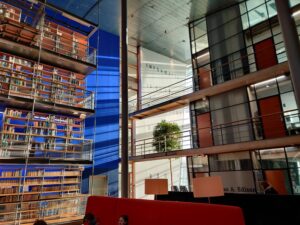
But this does not mean that TU Delft Library does not have growing, dynamic collections. There is a heritage collection, over 10,000 PhDs, a small but vibrant publishing house, a data repository as well as the traditional catalogue and books
But how to integrate these collections, some of them digital, some physical, and some in both formats, into the library space? How to reconnect with users and visitors and refresh the notion of browsing the library in the Internet era?
This has been the task of the Library’s resident designer and project leader, Alice Motta Maia Bodanzky.
Part of her work to re-envision the Library’s Collection Wall has been to invite bachelor students studying a module delivered by the university’s faculty of Industrial Design.
As part of their Interactive Minors module, these student teams were invited to create and prototype concepts for Content Modules (in the wall or nearby) that explored how to encourage visitors to discover and interact with the collection wall and the surrounding environment. These concepts were exhibited in the main hall at the Industrial Design faculty.
7 different concepts were presented, all inspiring in their ingenuity and creativity.
What was striking was the extent to which the concepts did not focus on addressing the library problem described above, ie. focussing on creating new ways to explore library collections.
Rather, the focus was on the library as a place, as a sensory experience. The collections were still less important than the feel of the space. How did visitors perceive and respond to the library interior as a whole?
So, for example, one team developed space for playful, imaginative games and also for chess.
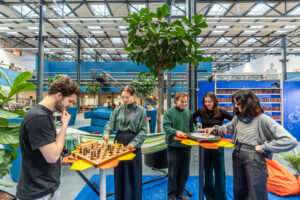
Another, citing the ‘stuffy atmosphere’ of the library created a breathing plant to help promote a sense of clean air.
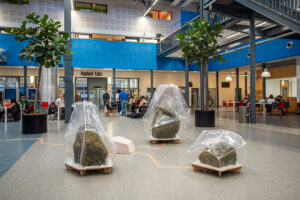
A third concept was a moving sculpture that would gently react to users walking next to the bookshelves.
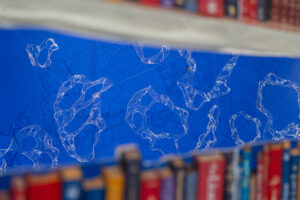
Not all the concepts were oriented in this way. The AI Tent allowed visitors to ask questions about scientific literature within a secluded space
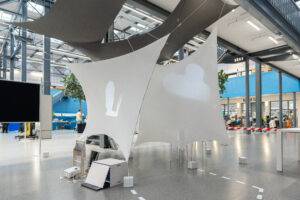
But very few of the concepts actually dealt with the knotty problem of how to better interact with the library collections.
This is not to criticise the projects. Indeed, Alice wishes to experiment with some of them in the library. But it’s more to illustrate a tendency of thinking of the library as more of a place to inhabit, to exist in, perhaps more so than a place to find knowledge.
This is not an isolated phenomenon. Museums have been evolving as architectural experiences for the past 25 years. Indeed, one could argue that much of recent public-facing architecture is extremely conscious of the physical experience of the visitor, irrespective of the specific reason they are visiting the building.
If this snapshot is correct, what does it imply for the future direction of libraries, particularly research-focussed libraries? How can we continue to undertake our essential roles – to provide access to diverse knowledge resources, foster critical thinking and support lifelong learning? While at the same time, respond to the growing need for physical spaces that provide a sense of physical well-being?
It may seem tricky to combine these two. But by continuing to innovate, to experiment with new ideas, some of which will work and some of which will not, we can create a new sense of what the library is.
